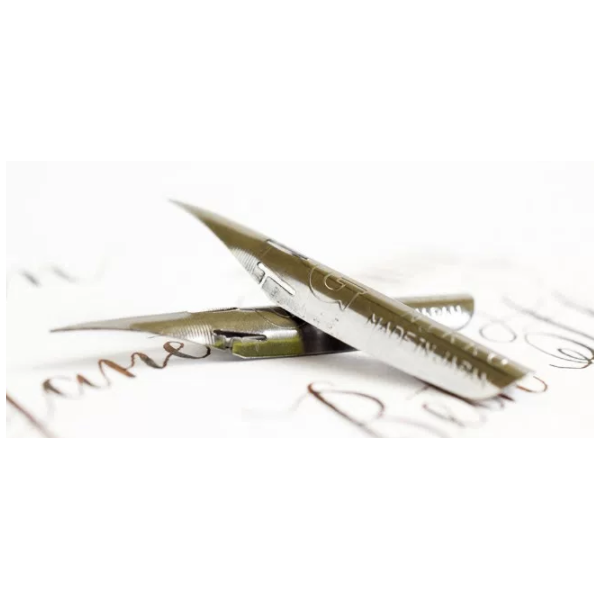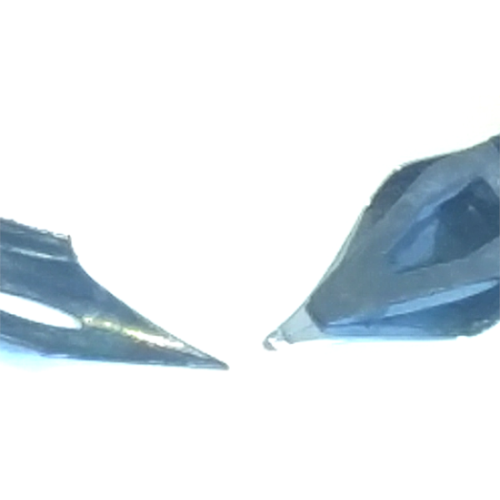Get in the habit of preparing dip nibs each time you use them. When you are using a new dip nib for the first time, you have to make sure there is no coating on the nib. Many manufacturers coat their dip nibs to protect them from rusting and to look better for purchase.
The coating can be something as light as a thin oil to a dried shellac. You have to remove the coating if you want ink to flow over the nib smoothly. Old timers used to pop new nibs into their mouth and roll it around with their tongue to clean it, but we aren't expecting you to do that.
You can wipe off an oil coat. You can peel or burn off a shellac coat. Gillott 303 nibs usually come shellacked.
Start by scratching the surface to tear the coat, then scrape it away. You can also hold the nib over a flame to burn off the coat, first from one end, then the other. If you don't remove the coating, the ink will flow poorly over the nib, or might not flow at all.
Dip nibs are typically inexpensive, mass produced items made from a material that can rust easily. This means you should check every dip nib you get before use. The quality control of most nib manufacturers is good, but mistakes happen. Be on the lookout for poorly trimmed edges and a lack of nib coating.
Poorly Trimmed Dip Nib Edges
Dip nibs are punched from spring steel, which is hard steel. Sometimes the punch doesn't trim the edge cleanly or pushes down the edge, as shown below for a Gillott 303 nib.

This edge prevents the nib from conforming correctly to the feed it sits on. The curved edge can prevent a tight fit of nib to feed, which means you won't get the flow of ink or paint that you want from a fountain pen.
In some cases, you can use dip nibs with bent edges, and there won't be a problem. In other cases, you might have to file the edges to make them smooth so they seat correctly. One solution is to bend out the edge manually using pliers or a hammer and punch. You should be skilled with the tools before you apply them to your nibs.
Dip Nib Coatings
Dip pen nibs are often coated after they’re made to protect against rust and wear until they are sold.
Factory Coated Dip Nibs
Since most pointed dip nibs are made from spring steel, which can rust easily, they are often coated at the factory to protect them. Some companies paint them with shellac, other companies dip the nibs in oil, which leaves a thin coat.
You can usually tell the difference by running your finger over the surface. An oil coating will feel slightly tacky, while a shellac coating can leave a feathered edge. If that doesn't work, try to scrape the surface of the dip pen nib with your fingernail. Oil will make your fingernail slide, while you might be able to scrape off some of the dried shellac.
The coating does a good job of protecting nibs. I've seen dip nibs produced many decades ago that are still in pristine shape thanks to their perfect coating of protection.
You have to remove the protection if you want to use the dip nib. The protection inhibits the flow of liquid over the surface of the nib, so ink and paint will ball up and refuse to flow until you clean the coating from the nib.
Removing Oil Coatings
Oil is easy to remove. Just soap the nib with dish soap or hand soap, then wash it off, and repeat several times. Sometimes you don't need water - wipe the nib clean with a tissue, then see how it works. Old timers would stick the oiled nib in their mouth and wash off the oil that way, but we don't recommend it.
Removing Other Coatings
Shellac and bluing are often applied to dip nibs. Gillott 303 nibs are given a coat of bluing. The best way to remove the bluing is touch the nib with a match flame. You will see the edge peel away quickly and disappear. You can see the difference below.


These are all Gillott 303 nibs. In the left image, the bottom nib has been cleared of shellac by burning. The top four nibs still retain the bluing. In the image on the right, the nibs have been flipped, and the cleaned nib is shown in the middle.
If you don't have matches handy, you can burn off the coating using another type of flame, such as a gas stove flame or BBQ fire starter. You can also scrape the surface of the nib with a fingernail to break the coating, then scrape away the film bit by bit.
Dealing with Rusted Dip Nibs
Check your nibs periodically to make sure they don't have any rust. Once a nib starts to rust, it is close to useless. The rust weakens the nib and produces a rough surface that can prevent a good fit with feed. You can draw with a nib that is rusted, but you can't stop the rust. We recommend that you throw out rusty nibs so they don't come in contact with your other dip nibs.



